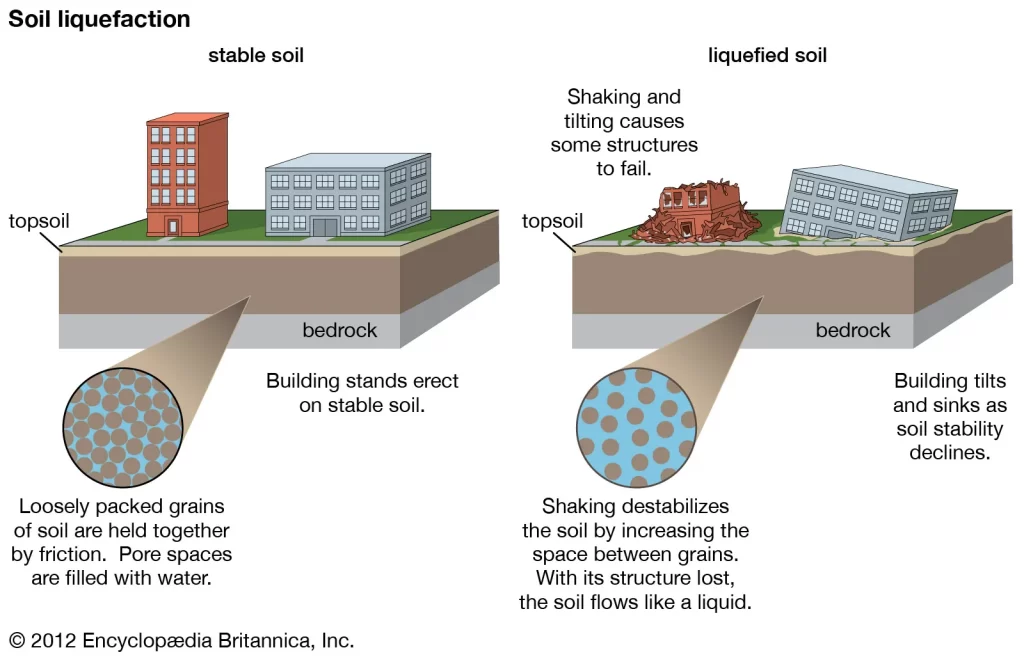Introduction
Puerto Rico is an area prone to earthquakes due to its location in the Caribbean region, specifically near the interaction zone of the Caribbean and North American tectonic plates. These plates are in constant motion and generate seismic activity in the region. Puerto Rico has experienced numerous earthquakes throughout its history, some of which have been of significant magnitude, in recent history, 2019 and 2020 have given demonstrations of this. Source: https://www.researchgate.net/publication/339474415_Actividad_sismica_en_Puerto_Rico_y_sus_alrededores. In another article we will delve into this characterization.
Earthquakes have various effects, with some particularly influenced by local or terrain factors. These include landslides, overturning, amplification, tsunamis, and the specific issue we wish to address in this post: liquefaction.

What is it liquefaction?
Liquefaction, in general terms, refers to the temporary loss of strength and transformation into a liquid or semi-liquid state by water-saturated soils. This phenomenon commonly occurs in granular soils like sands, specifically under specific conditions during an earthquake.
The Puerto Rico Seismic Network expresses about this phenomenon:
Liquefaction effects become apparent in flat, low-lying, or swampy areas. When an earthquake strikes these regions, the groundwater table rises, rendering the surface soft and leading buildings or structures to collapse on one side. To identify areas with high liquefaction potential, experts analyze the interaction between ground movement intensity and the resistance it encounters.
Source: https://redsismica.uprm.edu/spanish/educacion/efectos_secundarios.php
In essence, the occurrence of liquefaction during an earthquake can be attributed to the soil’s response to vibrations. The interstitial water between soil particles becomes pressurized, thereby leading to the separation of individual particles from one another. Consequently, the soil’s ability to bear weight is compromised, rendering it akin to a liquid. This metamorphosis can result in severe structural ramifications, such as building collapse or inclination, extensive damage, and disruption of vital public services.
In the case of Puerto Rico, cases of liquefaction have been reported during past earthquakes, including the seismic sequence that occurred in January 2020. As expected, liquefaction can vary depending on the composition of the soil and the intensity of the earthquake.
Alternatives to mitigate the risks associated
Construction and soil technology has developed techniques that help prevent soil liquefaction or reduce the negative effects of this phenomenon on structures. Some associated techniques:
- Soil improvement techniques: such as compaction, consolidation or dynamic compaction to increase soil density.
- Seismic Drains: installation of drainage systems to reduce excess water in the soil and decrease pore pressure.
- Soil reinforcement: use of techniques such as the injection of gravel columns or the installation of piles to increase the resistance and stability of the soil.
- Control of water saturation: Monitoring and control of the water table and water saturation in the soil.
- And of course, and related to the previous techniques, an essential form of mitigation is the appropriate structural design. That is, consider the possibility of liquefaction when designing structures, using deep foundations or specific mitigation techniques.
Remember that it is important to consult experts in geotechnical engineering to evaluate and apply the most appropriate techniques according to the characteristics of the soil and the specific context.
Regarding Seismic Drains
Seismic drains are comprised of vertical pipes that are installed into the ground, specifically designed to facilitate water flow while preventing soil ingress. These pipes are interconnected with a drainage system. During an earthquake event, these pipes effectively minimize excess pressure and reduce the liquefaction effect by enabling vertical displacement of water.
Tips for Seismic Drains
- Drains consist of perforated and corrugated plastic pipes wrapped in filter cloth; typically four-inch nominal diameter.
- Seismic drains provide a drainage path for the rapid dissipation of pore pressures generated during a seismic event.
- The spacing of the drains must be close enough to ensure rapid dissipation of the pressures generated by the earthquake. Typical spacings range from four to six feet, depending on the density of the liquefiable deposit and the magnitude of the design earthquake. This spacing depends on the permeability of the treated soil, although it rarely exceeds six feet center to center.
- Seismic drainage systems are specifically designed to withstand powerful seismic forces and safeguard structures from potential damage. This requires careful consideration of load capacity, strength, and stiffness when selecting system components such as pipes, fittings, and anchoring elements.
- Proper installation of earthquake drainage systems is crucial to their effectiveness. The manufacturer’s recommendations must be followed and special attention must be paid to the correct connection and fixing of the components.
These bullet points are general terms, since the design of a seismic drainage project presents a complexity specific to each context that must be addressed by a qualified professional in the field.
In closing
Engineering has made significant advancements in technologies associated with soil improvement. As mentioned in this Post, techniques such as Seismic drains, Geopiers(R), Stone Columns, Soil Mixing, Piling, Curtain Walls, Chemical Grouting, and Compaction Grouting, among others, have proven effective in minimizing the risks associated with soil liquefaction during seismic events. It is imperative to leverage these techniques to safeguard critical infrastructure and enhance resilience in susceptible regions.
At Nexo Tecnico, we specialize in studying the unique technical aspects of every project with meticulous attention to detail. Our expertise lies in resolving structural and geotechnical issues. We are dedicated to providing top-notch service. Feel free to reach out to us for more information and assistance.


